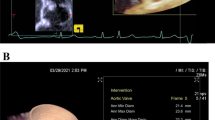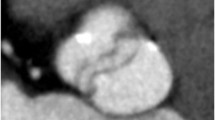Abstract
The aim of this study was to provide an insight into normative values of the ascending aorta in regards to novel endovascular procedures using ECG-gated multi-detector CT angiography. Seventy-seven adult patients without ascending aortic abnormalities were evaluated. Measurements at relevant levels of the aortic root and ascending aorta were obtained. Diameter variations of the ascending aorta during cardiac cycle were also considered. Mean diameters (mm) were as follows: LV outflow tract 20.3 ± 3.4, coronary sinus 34.2 ± 4.1, sino-tubular junction 29.7 ± 3.4 and mid ascending aorta 32.7 ± 3.8 with coefficients of variation (CV) ranging from 12 to 17%. Mean distances (mm) were: from the plane passing through the proximal insertions of the aortic valve cusps to the right brachio-cephalic artery (BCA) 92.6 ± 11.8, from the plane passing through the proximal insertions of the aortic valve cusps to the proximal coronary ostium 12.1 ± 3.7, and between both coronary ostia 7.2 ± 3.1, minimal arc of the ascending aorta from left coronary ostium to right BCA 52.9 ± 9.5, and the fibrous continuity between the aortic valve and the anterior leaflet of the mitral valve 14.6 ± 3.3, CV 13–43%. Mean aortic valve area was 582.0 ± 131.9 mm2. The variation of the antero-posterior and transverse diameters of the ascending aorta during the cardiac cycle were 8.4% and 7.3%, respectively. Results showed large inter-individual variations in diameters and distances but with limited intra-individual variations during the cardiac cycle. A personalized approach for planning endovascular devices must be considered.




Similar content being viewed by others
References
Dubost C, Allary M, Oeconomos N (1951) Aneurysm of the abdominal aorta treated by resection and graft. Arch Mal Coeur Vaiss 44:848–851
Dubost C, Allary M, Oeconomos N (1952) Resection of an aneurysm of the abdominal aorta: reestablishment of the continuity by a preserved human arterial graft, with result after five months. AMA Arch Surg 64:405–408
Creech O Jr (1966) Endo-aneurysmorrhaphy and treatment of aortic aneurysm. Ann Surg 164:935–946
Parodi JC, Palmaz JC, Barone HD (1991) Transfemoral intraluminal graft implantation for abdominal aortic aneurysms. Ann Vasc Surg 5:491–499
Parker MV, O’Donnell SD, Chang AS, Johnson CA, Gillespie DL, Goff JM, Rasmussen TE, Rich NM (2005) What imaging studies are necessary for abdominal aortic endograft sizing? A prospective blinded study using conventional computed tomography, aortography, and three-dimensional computed tomography. J Vasc surg 41:199–205
Moon MC, Morales JP, Greenberg RK (2007) The aortic arch and ascending aorta: are they within the endovascular realm? Semin Vasc Surg 20:97–107
Huber CH, von Segesser LK (2006) Direct access valve replacement (DAVR) – are we entering a new era in cardiac surgery? Eur J Cardiothorac Surg 29:380–385
Ishimaru S (2004) Endografting of the aortic arch. J Endovasc Ther 11 Suppl 2:II62–71
Kasirajan K (2006) Thoracic endografts: procedural steps, technical pitfalls and how to avoid them. Semin Vasc Surg 19:3–10
Aronberg DJ, Glazer HS, Madsen K, Sagel SS (1984) Normal thoracic aortic diameters by computed tomography. J Comput Assist Tomogr 8:247–250
Pearce WH, Slaughter MS, LeMaire S, Salyapongse AN, Feinglass J, McCarthy WJ, Yao JS (1993) Aortic diameter as a function of age, gender, and body surface area. Surgery 114:691–697
Fitzgerald SW, Donaldson JS, Poznanski AK (1987) Pediatric thoracic aorta: normal measurements determined with CT. Radiology 165:667–669
Hager A, Kaemmerer H, Rapp-Berhhardt U, Blücher S, Rapp K, Bernhardt TM, Galanski M, Hess J (2002) Diameters of the thoracic aorta throughout life as measured with helical computed tomography. J Thorac Cardiovasc Surg 123:1060–1066
Rubin GD, Leung AN, Robertson VJ, Stark P (1998) Thoracic spiral CT: influence of subsecond gantry rotation on image quality. Radiology 208:771–776
Qanadli SD, El Hajiam M, Mesurolle B, Lavisse L, Jourdan O, Randoux B, Chagnon S, Lacombe P (1999) Motion artifacts of the aorta simulating aortic dissection on spiral CT. J Comput Assist Tomogr 23:1–6
Duvernoy O, Coulden R, Ytterberg C (1995) Aortic motion: a potential pitfall in CT imaging of dissection in the ascending aorta. J Comput Assist Tomogr 19:569–572
Marten K, Funke M, Rummeny EJ, Engelke C (2005) Electrocardiographic assistance in multidetector CT of thoracic disorders. Clin Radiol 60:8–21
Roos JE, William JK, Weishaupt D, Lachat M, Marincek B, Hilfiker PR (2002) Thoracic aorta: motion artifact reduction with retrospective and prospective electrocardiography-assisted multi-detector row CT. Radiology 222:271–277
Schertler T, Glücker T, Wildermuth S, Jungius KP, Marincek B, Boehm T (2005) Comparison of retrospectively ECG-gated and nongated MDCT of the chest in an emergency setting regarding workflow, image quality, and diagnostic certainty. Emerg Radiol 12:19–29
O’Brien JP, Srichai MB, Hecht EM, Kim DC, Jacobs JE (2007) Anatomy of the heart at multidetector CT: what the radiologist needs to know. Radiographics 27:1569–1582
Horiguchi J, Kiguchi M, Fujioka C, Shen Y, Arie R, Sunasaka K, Ito K (2008) Radiation dose, image quality, stenosis mesurement, and CT densitometry using ECG-triggered coronary 64-MDCT angiography: a phantom study. AJR Am J Roentgenol 190:315–320
van Prehn J, Vincken KL, Muhs BE, Barwegen GK, Bartels LW, Prokop M, Moll FL, Verhagen HJ (2007) Toward endografting of the ascending aorta: insight into dynamics using dynamic cine-CTA. J Endovasc Ther 14:551–60
Ganten M, Krautter U, Hosch W, Hansmann J, von Tengg-Kobligk H, Delorme S, Kauczor HU, Kauffmann GW, Bock M (2007) Age related change of human aortic distensibility: evaluation with ECG-gated CT. Eur Radiol 17:701–708
Poutanen T, Tikanoja T, Sairanen H, Jokinen E (2003) Normal aortic dimensions and flow in 168 children and young adults. Clin Physiol Funct Imaging 23:224–229
Smiseth OA, Stoylen A, Ihlen H (2004) Tissue Doppler imaging for the diagnosis of coronary artery disease. Curr Opin Cardiol 19:421–429
Van Dantzig JM (2006) Echocardiography in the emergency department. Semin Cardiothorac Vasc Anesth 10:79–81
Erbel R, Mohr-Kahaly S, Oelert H, Iversen S, Jakob H, Thelen M, Just M, Meyer J (1992) Diagnostic goals in aortic dissection. Value of transthoracic and transesophageal echocardiography. Herz 17:321–37
Appelbe AF, Walker PG, Yeoh JK, Bonitatibus A, Yoganathan AP, Martin RP (1993) Clinical significance and origin of artifacts in transesophageal echocardiography of the thoracic aorta. J Am Coll Cardiol 21:754–760
Clarkson PM, Brandt PW (1985) Aortic diameters in infants and young children: normative angiographic data. Pediatr Cardiol 6:3–6
Trivedi KR, Pinzon JL, McCrindle BW, Burrows PE, Freedom RM, Benson LN (2002) Cineangiographic aortic dimensions in normal children. Cardiol Young 12:339–344
Finet G, Masquet C, Eifferman A, Funck F, Lefèvre T, Marco J, Amiel M, Beaune J, Liénard J (1996) Can we optimize our angiographic views every time? Qualitative and quantitative evaluation of a new functionality. Invest Radiol 31:523–531
Lorenz CH (2000) The range of normal values of cardiovascular structures in infants, children, and adolescents measured by magnetic resonance imaging. Pediatr Cardiol 21:37–46
Kim YC, Nielsen JF, Nayak KS (2008) Automatic correction of echo-planar imaging (EPI) ghosting artifacts in real-time interactive cardiac MRI using sensitivity encoding. J Magn Reson Imaging 27:239–245
Tenforde TS (2005) Magnetically induced electric fields and currents in the circulatory system. Prog Biophys Mol Biol 87:279–288
Wyers MC, Fillinger MF, Schermerhorn ML, Powell RJ, Rzucidio EM, Walsh DB, Zwolak RM, Cronenwett JL (2003) Endovascular repair of abdominal aortic aneurysm without preoperative arteriography. J Vasc Surg 38:730–738
von Ludinghausen M (2003) The clinical anatomy of coronary arteries. Adv Anat Embryol Cell Biol 167:III–VIII, 1–111
Huber CH, Tozzi P, Corno AF, Marty B, Ruchat P, Gersbach P, Nasratulla M, von Segesser LK (2004) Do valved stents compromise coronary flow? Eur J Cardiothorac Surg 25:754–759
Author information
Authors and Affiliations
Corresponding author
Additional information
There is no conflict of interest or financial support concerning this study.
Rights and permissions
About this article
Cite this article
Lu, TL.C., Huber, C.H., Rizzo, E. et al. Ascending aorta measurements as assessed by ECG-gated multi-detector computed tomography: a pilot study to establish normative values for transcatheter therapies. Eur Radiol 19, 664–669 (2009). https://doi.org/10.1007/s00330-008-1182-8
Received:
Revised:
Accepted:
Published:
Issue Date:
DOI: https://doi.org/10.1007/s00330-008-1182-8




